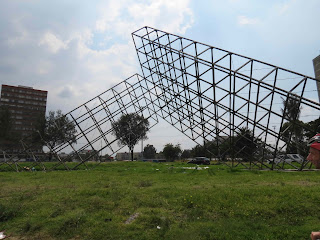 |
| Construction equipment parked on an illegal road near La Calerain Bogotá's Eastern Hills. (Photo from El Tiempo/CityTV) |
They rise up on the city's eastern edge, providing a green, forested backdrop to Colombia's capital, as well as a source of vital fresh air.
 |
Bogotá's Eastern Hills provide a sweeping green
backdrop for the city. |
But Bogotá's Eastern Hills are under constant attack, as a
pair of articles in El Tiempo yesterday and today chronicled. A rancher near La Calera in north Bogotá built an acess road across his land, illegaly and without obtaining permits. The road damaged three separate protected forests, according to experts interviewed by the paper, and polluted one of the rivers flowing into the capital.
But the road's biggest impact may happen in the next years if the environmental officials do not succeed in removing it. That's because it'll enable the construction of homes and other buildings in the area, further destroying the forests.
The landowner who created the road sounded unrepentant, telling
El Tiempo only that he wanted to be able to drive across his property to observe his cattle.
 |
The cable car station to Monserrate and the
Virgin de Guadalupe statue behind. |
This road is a small-scale example of one of the greatest threats to Colombia's forests: While mining, oil wells and other types of resource extraction cause damage themselves, their greatest impacts occur in the following years, as farmers and ranchers use roads and pipeline rights-of-way to invade virgin areas and carry out more deforestation.
This road is only the most recent attack on Bogotá's Estern Hills, which are protected by law, but where both rich and poor try to build houses illegaly.
But the damage to forests is only one fundamental tragedy of the Eastern Hills of Bogotá. Because of the area's isolation and the many rough neighborhoods along the base of the hills, the hills have a reputation for crime.
 |
| A view of central Bogotá from the hills. |
About five years ago, some friends and I hiked to the top of Monserrate, then down the back of the hills and back into Bogotá via the canyons behind the Parque Nacional. We took precautions, including carrying big sticks and bringing along several pit bulls. Even so, we kept silent for long stretches of the walk so that the tough kids in the
barrios down below wouldnpt hear us and and come out in pursuit. In the end, we had a great time walking thru peaceful pine and eucalyptus forests, where we felt as tho we were in a different world, far from Bogotá's noise and pollution.
We planned to do another hike the following Sunday. But on Saturday part of the hills caught fire and a family visiting their grandfather's ashes, which they'd scattered behind the Parque Nacional, was gunned down in a mugging gone awry. We canceled our second hike, and I haven't been back since.
There have since been many more crimes in the Eastern Hills, including a dramatic one in north Bogotá last year, in which muggers stopped hikers at gunpoint one by one and took them to a field, where they robbed them and held them for hours until they'd succeeded in methodically robbing several dozen people.
I grew up in the San Franciso, (California) Bay Area, where we loved going hiking, bicycling and picnicing in the Berkeley Hills. Bogotá's Eastern Hills could be a similar wonderful resource for the nine million people trapped in the capital's stress, noise and pollution, especially for those who don't have the time or money to leave the city.
The situation is a sort of Catch-22: As long as few people venture into the hills, they'll remain isolated and dangerous. But unless more people start recreating in the hills, they won't become safer.
The city has plans to turn the Eastern Hills into a park, complete with hiking and cycling trails. But they haven't advanced. Such plans will require lots of money and planning. However, the city might start on a small scale, creating secure trails and exhibits, which would be steadily expanded as more and more people venture into the hills. Perhaps some of the kids who now occupy themselves by mugging people could even be employed in these projects.
By Mike Ceaser, of
Bogotá Bike Tours





















































